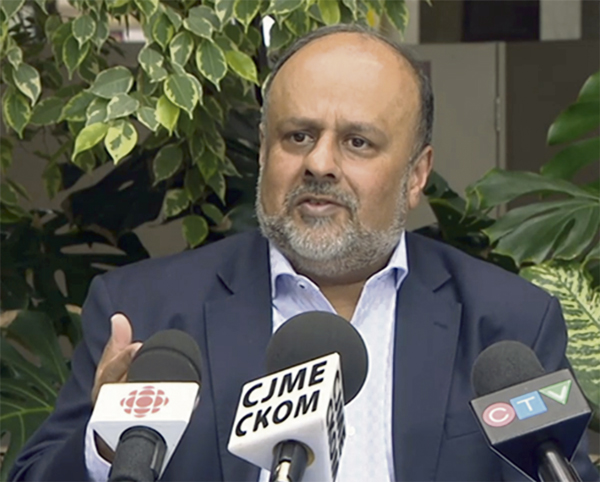The provincial death toll from COVID-19 jumped by nine cases today as the province addressed a reporting issue on its dashboard.
One of those deaths was in the North Central zone, meaning 90 people have now died after contracting the virus in Prince Albert and surrounding communities.
“There were several anomalies that were identified, including potential missing data which has been corrected,” Provincial Medical Officer of Health Dr. Saqib Shahab said in an online media briefing on Jan. 21.
“A key finding from this review is that there were nine deaths unfortunately reported related to COVID since Jan 1, 2022 that were not on the dashboard so those have since been added,” he said.
Shahab attributed the issue to the change in the calendar year.
“There was a flag that was brought up that because no deaths were being reported, is there an issue with the filters and that was exactly what was found,” he said.
The provincial NDP are chastising the province and Premier Scott Moe, saying the premier is choosing which numbers he talks about in an effort to spin the data.
“The premier chose to share cherry-picked hospitalization statistics that support his political narrative while withholding credible data forecasting a best-case scenario of imminent health care disaster,” said the Official Opposition party in an emailed statement.
They also want to see stronger measures from the province to slow the growth of the virus in Saskatchewan.
“The premier told Saskatchewan people he regretted not acting sooner in the fourth wave. So why now, with the benefit of hindsight and foresight, is he again choosing to gamble with a potential health system collapse?” said Health Critic Vicki Mowat. “What we’re getting from the premier is a dishonest and politically-driven campaign to justify doing nothing.”
Also added to the dashboard today from the same glitch, were 11 ICU admissions that are no longer current, 86 inpatient admissions, also historic, and 2,233 now-resolved COVID cases in the larger population.
Shahab said the numbers that were added since the start of January were not impacted by the problem.
The dashboard will continue to be monitored and updated to keep the information timely and accurate, he explained.
Of the nine new deaths, three were in the Central East, North Central and South Central in the 80 and over age group, two were in the 70 to 79 age range from Central West and South East, two in their 60s from South Central and South East and two in the 80-plus range from the South Central area.
The data is becoming increasingly complex,” Shahab said. Some of the data that is added to the dashboard is not funneled through Panorama, the health information system the province uses, but instead is added directly by labs or hospitals.
Guidelines around reporting COVID deaths
For the last several weeks, the province has broken down hospitalizations and ICU admissions that are positive for COVID in two ways, as COVID-related or incidental.
Shahab said that the different variants of the virus have had an impact.
“It’s getting more complex. As an example, during the Delta wave, someone in their 40s, unvaccinated, in ICU with COVID-related pneumonia who unfortunately – many in that age range passed away in the fall– that was obviously a COVID related death,” he said. “That would have been picked up immediately.”
He said over the next few weeks as the extremely-contagious Omicron variant continues to grow, more deaths will happen.
“We still may see over the next few weeks, deaths that are primarily due to COVID. Those are hard to miss. They’re very obvious especially if its someone that is otherwise healthy and has no co-morbidities.”
Shahab used influenza as an example, which has a new vaccine every year to best combat whichever strains are most likely to be dominant. People who are frail or have underlying co-morbidities, can get the virus which then triggers a series of health issues that can then result in hospitalization and death.
Sometimes it’s the other way around and a person who is admitted for an injury caused by a vehicle collision can also test positive but the virus is not the reason for their care.
“But in between you have many complex presentations where somebody may be in for a heart attack but screen positive for COVID,” said Shahab. “That most likely, the COVID is incidental but the COVID starts complicating the clinical picture. If the person passes away, that still has to be assessed.”
A person with chronic lung disease who also contracts COVID and then requires hospitalizations leads to different criteria as well.
COVID can be listed as a contributing cause or a primary cause on the death certificate.
“I think we have to report consistently not just across Saskatchewan, but all provinces for data comparability,” Shahab said.
Incidental COVID impacts care
Even if a patient has incidental COVID, how the hospital cares for them changes as the spread must still be controlled.
Patients with COVID can have the virus impact other conditions such as a lung condition and the patient is managed for that but also, a patient who has no COVID symptoms still has a different care picture as transmission needs to be controlled to both other patients and staff.
“Once you are hospitalized you still require additional ways of infection prevention and control because you still want to minimize transmission of COVID. Care is still more complex. COVID may not be the reason for hospitalization but the COVID can complicate your clinical picture,” Shahab said.


